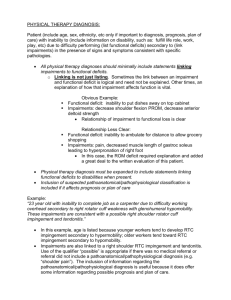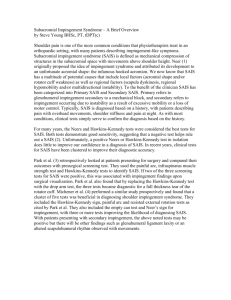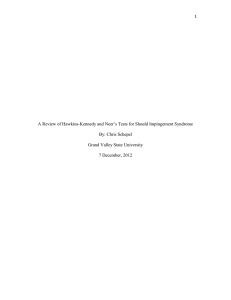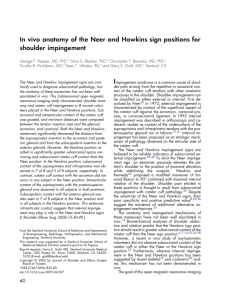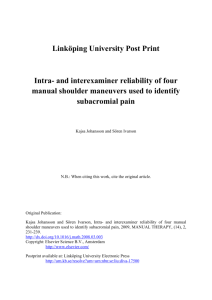The Neer sign and Hawkins-Kennedy test for shoulder impingement
advertisement
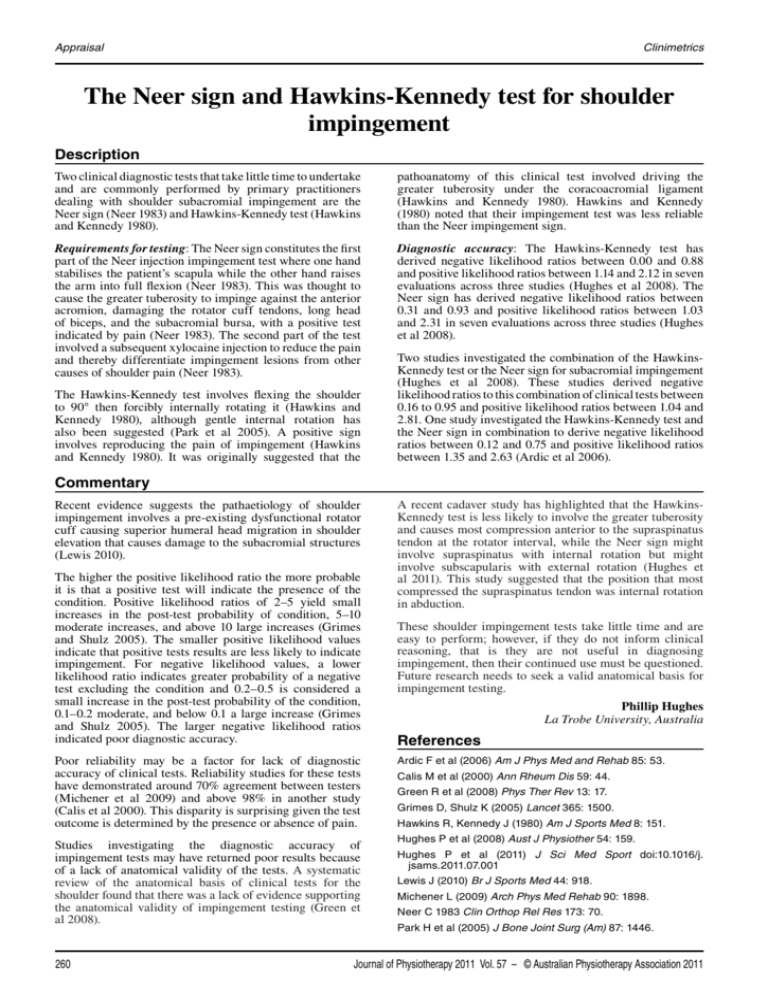
Appraisal Clinimetrics The Neer sign and Hawkins-Kennedy test for shoulder impingement Description Two clinical diagnostic tests that take little time to undertake and are commonly performed by primary practitioners dealing with shoulder subacromial impingement are the Neer sign (Neer 1983) and Hawkins-Kennedy test (Hawkins and Kennedy 1980). pathoanatomy of this clinical test involved driving the greater tuberosity under the coracoacromial ligament (Hawkins and Kennedy 1980). Hawkins and Kennedy (1980) noted that their impingement test was less reliable than the Neer impingement sign. Requirements for testing: The Neer sign constitutes the first part of the Neer injection impingement test where one hand stabilises the patient’s scapula while the other hand raises the arm into full flexion (Neer 1983). This was thought to cause the greater tuberosity to impinge against the anterior acromion, damaging the rotator cuff tendons, long head of biceps, and the subacromial bursa, with a positive test indicated by pain (Neer 1983). The second part of the test involved a subsequent xylocaine injection to reduce the pain and thereby differentiate impingement lesions from other causes of shoulder pain (Neer 1983). Diagnostic accuracy: The Hawkins-Kennedy test has derived negative likelihood ratios between 0.00 and 0.88 and positive likelihood ratios between 1.14 and 2.12 in seven evaluations across three studies (Hughes et al 2008). The Neer sign has derived negative likelihood ratios between 0.31 and 0.93 and positive likelihood ratios between 1.03 and 2.31 in seven evaluations across three studies (Hughes et al 2008). The Hawkins-Kennedy test involves flexing the shoulder to 90° then forcibly internally rotating it (Hawkins and Kennedy 1980), although gentle internal rotation has also been suggested (Park et al 2005). A positive sign involves reproducing the pain of impingement (Hawkins and Kennedy 1980). It was originally suggested that the Two studies investigated the combination of the HawkinsKennedy test or the Neer sign for subacromial impingement (Hughes et al 2008). These studies derived negative likelihood ratios to this combination of clinical tests between 0.16 to 0.95 and positive likelihood ratios between 1.04 and 2.81. One study investigated the Hawkins-Kennedy test and the Neer sign in combination to derive negative likelihood ratios between 0.12 and 0.75 and positive likelihood ratios between 1.35 and 2.63 (Ardic et al 2006). Commentary Recent evidence suggests the pathaetiology of shoulder impingement involves a pre-existing dysfunctional rotator cuff causing superior humeral head migration in shoulder elevation that causes damage to the subacromial structures (Lewis 2010). The higher the positive likelihood ratio the more probable it is that a positive test will indicate the presence of the condition. Positive likelihood ratios of 2–5 yield small increases in the post-test probability of condition, 5–10 moderate increases, and above 10 large increases (Grimes and Shulz 2005). The smaller positive likelihood values indicate that positive tests results are less likely to indicate impingement. For negative likelihood values, a lower likelihood ratio indicates greater probability of a negative test excluding the condition and 0.2–0.5 is considered a small increase in the post-test probability of the condition, 0.1–0.2 moderate, and below 0.1 a large increase (Grimes and Shulz 2005). The larger negative likelihood ratios indicated poor diagnostic accuracy. Poor reliability may be a factor for lack of diagnostic accuracy of clinical tests. Reliability studies for these tests have demonstrated around 70% agreement between testers (Michener et al 2009) and above 98% in another study (Calis et al 2000). This disparity is surprising given the test outcome is determined by the presence or absence of pain. Studies investigating the diagnostic accuracy of impingement tests may have returned poor results because of a lack of anatomical validity of the tests. A systematic review of the anatomical basis of clinical tests for the shoulder found that there was a lack of evidence supporting the anatomical validity of impingement testing (Green et al 2008). 260 A recent cadaver study has highlighted that the HawkinsKennedy test is less likely to involve the greater tuberosity and causes most compression anterior to the supraspinatus tendon at the rotator interval, while the Neer sign might involve supraspinatus with internal rotation but might involve subscapularis with external rotation (Hughes et al 2011). This study suggested that the position that most compressed the supraspinatus tendon was internal rotation in abduction. These shoulder impingement tests take little time and are easy to perform; however, if they do not inform clinical reasoning, that is they are not useful in diagnosing impingement, then their continued use must be questioned. Future research needs to seek a valid anatomical basis for impingement testing. Phillip Hughes La Trobe University, Australia References Ardic F et al (2006) Am J Phys Med and Rehab 85: 53. Calis M et al (2000) Ann Rheum Dis 59: 44. Green R et al (2008) Phys Ther Rev 13: 17. Grimes D, Shulz K (2005) Lancet 365: 1500. Hawkins R, Kennedy J (1980) Am J Sports Med 8: 151. Hughes P et al (2008) Aust J Physiother 54: 159. Hughes P et al (2011) J Sci Med Sport Ze_0'&$'&',%`$ jsams.2011.07.001 Lewis J (2010) Br J Sports Med 44: 918. Michener L (2009) Arch Phys Med Rehab 90: 1898. Neer C 1983 Clin Orthop Rel Res 173: 70. Park H et al (2005) J Bone Joint Surg (Am) 87: 1446. Journal of Physiotherapy 2011 Vol. 57 – © Australian Physiotherapy Association 2011




